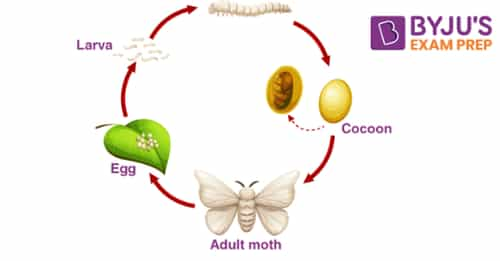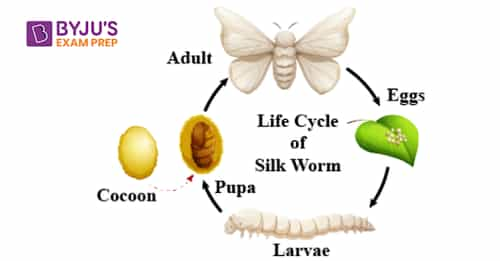The Life Cycle of Silkworm demonstrates the five stages wherein a female moth is formed from the egg. A yarn or silk thread is developed from the silk moth's cocoon. Here you will study the Silkworm life cycle in detail, but before that, it is important to know what fibres are and how they are obtained.
The major usage of silkworms is for producing single yarn out of discontinuous cocoon filament for obtaining silk using the process of spinning. Fiber is a substance that is made up of continuous and thin strands. They are classified into 2 types: natural and synthetic fibre. Silk is a type of animal or natural fibre obtained directly from animals.

History of a Silkworm
Before reading about the full life cycle of the mulberry silkworm, it is necessary to have some knowledge about the history of a silkworm. The brief history of silk is mentioned below.
- It was found in China around 3500 BC (before Christ).
- Silk was transported through trade to various parts of the world for many years.
- Manufacturers have been able to form varieties types of silk depending on their texture and shine using technology and the latest developments.
- The most popular silk moth is Mulberry silk.
The Life Cycle of Silkworm
The beginning of the life cycle of a silkworm is marked when a female silk moth lays eggs. After the completion of the cycle, the silk thread (yarn) is fetched from the silk moth's cocoon. The Silkworm life cycle completes between 6-8 weeks. The life cycle of the silkworm is described below in detail.
Stage 1 - Egg
The egg is the first stage in a silkworm's life cycle. A female butterfly lays more than 350 eggs in one go; each one is equivalent to the size of a dot. Once every year during spring, the eggs finally hatch due to the warming weather of the season.
Stage 2 - Silkworm
The maximum growth of silkworms occurs during the second stage of the life cycle of silkworms. After the cracking of the eggs, a hairy silkworm is formed. A caterpillar or larvae consume a huge amount of mulberry leaves for a month (approximately 30 days) before reaching the third stage.
Stage 3 - Cocoon
A cocoon is an envelope composed largely of silk that an insect larva forms to shelter itself while growing. It is similar to the size of a round cotton mall and is created with a single silk thread.
Stage 4 - Pupa
The fourth stage in the life cycle of a silkworm is the pupa stage. It is known to be a completely motionless process. The manufacturers kill the pupa by dropping the fully developed cocoon into boiling water and unrolling the silk yarn.
Stage 5 - Moth
Changing the pupa into an adult moth is the final stage of a silkworm's life cycle. The female moth breeds and produces eggs. After this stage, the whole life cycle begins again.
Factors Affecting the Life Cycle of Silkworm
The total time duration of a silkworm to develop into a moth can take up to 8 weeks. A bunch of factors that affect the life cycle of a silkworm is given below.
- The warmer the temperature, the early the silkworm completes its life cycle.
- Other crucial factors include exposure to sunlight and humidity.
- The ideal conditions are listed in the table given. In case adequate factors like sunlight, darkness, temperature, and humidity levels are not achieved, there are chances that an incubator can be required.
Factors Affecting the Life Cycle of Silkworm | Ideal requirement |
Sunlight | 12 hours/day |
Darkness | 12 hours/day |
Temperature | 23-28 degrees celsius |
Humidity levels | 85-90% |
Ideal hatching period | 7-10 days |
Processing of Silk
An important procedure performed after the completion of the life cycle of the silkworm is the processing of silk. In this method, the cocoons are kept in sunlight from which silk threads are isolated. Silk rearing is the process in which silk is loosened up from the cocoon.
The silk threads received are bleached, and the silk is spun into yarns from the fibres. After spinning, the threads are collected together from yarns.
Sericulture in the Life Cycle of Silkworm
The process involving the raising of silkworms and their cultivation is referred to as Sericulture. The production of silk is crucial in many household and textile industries. China is considered to be the leading producer of silk in the world.
- Mori culture – Growing mulberry leaves utilized by silkworms as their food and nutrition for growth.
- Rearing of Silkworm - The process involving the maturation and development of silkworms.
- Silk Reeling - The method where silk is extracted from the cocoon.
☛ Also Read: Current Affairs Today
Life Cycle of Silkworm Diagram
This page explains the life cycle of the silkworm for class 7th in detail. Readers can look at the diagram below, which shows the life cycle of the silkworm.
Life Cycle of Silkworm stage | Number of days |
Eggs | 10-25 days |
Lava and worms | 20-33 days |
Pupa | 10-14 days |
Moth | 5-10 days |

FAQs on the Life Cycle of Silkworm
How many stages are present in the Life Cycle of Silkworm?
The life cycle of a silkworm consists of a total of 5 stages - egg, silkworm, cocoon, pupa, and the moth. After the formation of a fully grown female moth at the last stage, the process again begins and continues.
What is the pupa stage in the life cycle of silkworms?
The pupa stage is the fourth phase in the life cycle of a silkworm. It is a completely motionless process. The people in the industries kill the pupa by dropping the fully developed cocoon into boiling water and then uncoiling the silk yarn.
What is Sericulture?
The process involving the raising of silkworms and their cultivation is referred to as Sericulture. The production of silk is crucial in many household and textile industries. It involves steps like more culture, rearing of the silkworm, and silk reeling.
What is the need for the processing of silk after the life cycle of a silkworm?
During silk processing, cocoons are kept in sunlight from which silk threads are isolated. Silk rearing is the process in which silk is loosened up from the cocoon. The silk threads received are bleached, and the silk is spun into yarns from the fibres. After spinning, the threads are collected together from yarns.
What are the factors affecting the Life Cycle of silkworms?
The total time duration of a silkworm to develop into a moth can take upto 8 weeks. Some significant factors include sunlight, darkness, temperature, and humidity levels. If these conditions are ideal, the hatching of the eggs takes 7-10 days.



